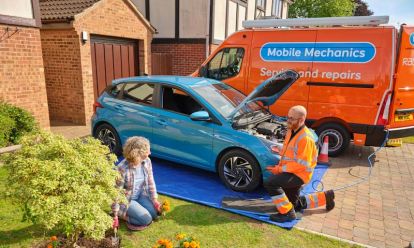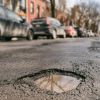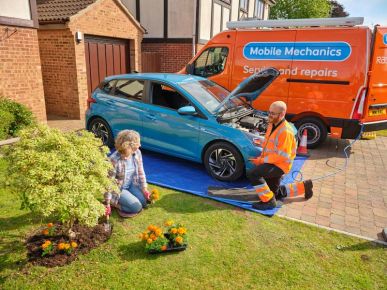ESP (also known as ESC) works in conjunction with your vehicle's anti-lock brakes (ABS) to prevent it from skidding or sliding out of control. It has been compulsory for most new cars since 2014 and has been proven to be a life saver because it can prevent you from losing control of your vehicle.
Find out more about ESP, warning lights and how it works in this guide.
What does ESP or ESC stand for on a car?
ESP stands for Electronic Stability Programme while ESC means Electronic Stability Control. Both are car safety features, designed to help the driver maintain control of the vehicle by minimising the risk of loss of traction or skidding.
Fitted as standard to most cars registered since 2014, ESP or ESC is an important piece of safety technology that sits in the background and acts when it detects danger. In most cases, you won’t ever know it’s fitted until you really need it.
How does ESP or ESC work on a car?
ESP or ESC is designed to prevent skidding or loss of traction when performing an emergency stop or driving in wet or slippery road conditions.
The system works via wheel speed sensors, steering angle sensors, and yaw rate sensors, to monitor the vehicle's speed, direction, and the driver's steering input.
The programme can compare a driver's intended direction (based on steering input) with the actual direction of the vehicle (based on sensor data).
If the system is working, then the vehicle can detect if a vehicle is not following the intended path and is at risk of losing control. It will then apply the brakes and reduce engine power to stabilise the wheels.
In short, ESP or ESC assists in preventing oversteer and understeer by adjusting brake forces and engine power.
What does the ESP or ESC warning light mean?

Knowing what your car dashboard warning lights mean is important for all drivers. If the yellow ESP or ESC warning symbol is illuminated on your vehicle's dashboard then it's important to understand what this means.
Flickering ESP or ESC warning light
The yellow ESP or ESC warning light will flicker on your vehicle's dashboard when the system is active. This usually happens when the vehicle is driven aggressively or a sudden loss of traction is detected when navigating a challenging bend in the road during difficult weather conditions.
In most cases, the ESP or ESC warning light will flicker on for a brief few seconds before going off again. You may also notice the engine power being cut or reduced, along with the brakes pulsating as the ESP system recovers control of the vehicle.
ESP or ESC light always on
If the ESP or ESC light stays on when you start the vehicle then the system has either developed a fault or has been deactivated.
Switching off the ESP or ESC system will often result in the light staying on, but you should always check the vehicle's owner's manual to double check this is the case.
If the ESP or ESC system hasn't been switched off but the light stays illuminated then it could be a sign of a fault. You can have ESP or ESC problems investigated by one of our RAC Mobile Mechanics or a trusted local garage.
What causes the ESP or ESC warning light to come on?
The ESP or ESC dashboard warning light comes on when a sensor detects a problem.
Common reasons for ESP or ESC warning light:
- Traction loss
- Faulty sensor(s)
- Brake pads or discs fault
- Faulty ABS system
- Incorrect wheel alignment
- Low tyre pressure
- Faulty wiring or connectors
- Damaged battery
- Corrupted software
- Bald tyres
Car troubles?
Book a diagnostic test with us today. RAC Mobile Mechanics will check your car for faults, talk you through any repairs you might need, and give you a report for your records.


Importance of ESP or ESC
Road safety is the top priority for drivers, and ESP or ESC plays a crucial role in this for all drivers, pedestrians, and other road users.
By enhancing stability, ESP or ESC reduces the risk of accidents, especially in challenging driving conditions like wet or icy roads, sharp turns, or when a driver needs to carry out a sudden evasive manoeuvre.
The programme also reduces the risk of a car rolling over – especially in taller and larger vehicles.
Like many modern safety features in vehicles, confidently knowing that their vehicle has ESP or ESC can boost a driver's confidence, especially in tricky weather or emergency situations.
What's the difference between EPS and ESC?
ESP and ESC are effectively the same thing. Electronic Stability Control (ESC) works in the same way as ESP and ESC is simply a name that some car manufacturers use to label their own stability control system.
Understanding ESP/ESC and other abbreviation
Other names for ESP or ESC include:
- DSC - Dynamic Stability Control
- PSM - Porsche Stability Management
- VSA - Vehicle Stability Assist
- ASC - Active Stability Control
- DSTC - Dynamic Stability and Traction Control
Are ESP or ESC and traction control the same?
Traction control and Electronic Stability Program (ESP) or Electronic Stability Control (ESC) are similar but provide different safety functions for the vehicle.
Although they are safety features that help improve stability and control, they focus on different issues.
Traction control prevents wheel spin and maintaining traction between the tyres and the road surface. The system reduces engine power or applies the brakes to the spinning wheels.
ESP or ESC uses sensors to continuously monitor factors such as vehicle speed, steering input, and wheel behaviour – and provide preventative power and braking when necessary.
Get a service or repair at home
RAC Mobile Mechanics can come to you, saving you the hassle of going to a garage.












